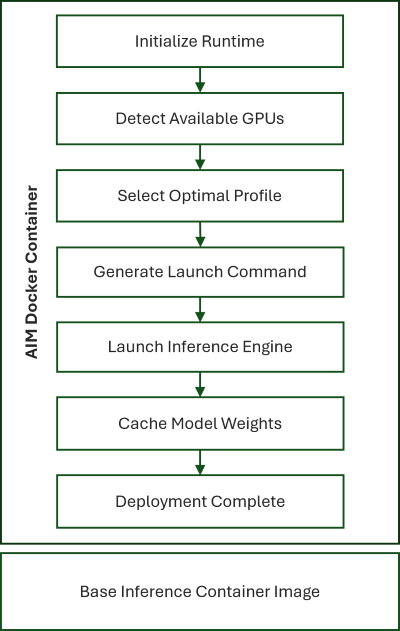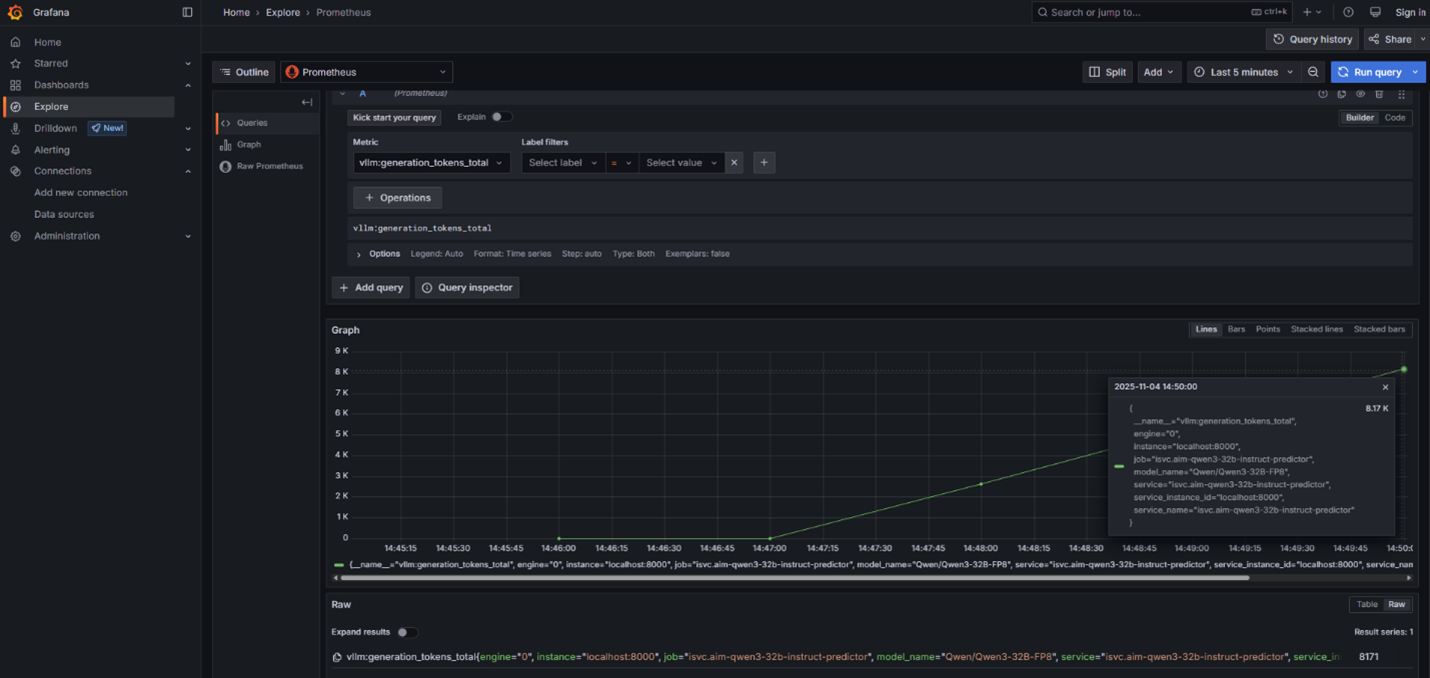AMD Inference Microservice (AIM): Production Ready Inference on AMD Instinct™ GPUs#

As generative AI models continue to expand in scale, context length, and operational complexity, enterprises face a harder challenge: how to deploy and operate inference reliably, efficiently, and at production scale. Running LLMs or multimodal models on real workloads requires more than high-performance GPUs. It requires reproducible deployments, predictable performance, seamless orchestration, and an operational framework that teams can trust.
This blog introduces AMD Inference Microservice (AIM), a production-ready framework that simplifies and accelerates AI model deployment on AMD Instinct™ GPUs. Built on ROCm™, integrated with Kubernetes, and aligned with enterprise workflows, AIM provides flexible, high-performance building blocks for serving LLMs, vision models, speech models, and agentic AI pipelines.
You will walk through how AIM works under the hood, how it enables scalable and optimized inference, and how enterprises can integrate AIM into existing AI platforms. This blog also illustrates the architecture, discusses key operational components, and explains how AIM delivers consistent performance across diverse AI workloads. If you are building or operating AI infrastructure, whether for prototyping, internal applications, or large-scale production, AIM helps reduce operational burden, provides predictable performance on AMD accelerators, and establishes a reproducible deployment workflow that your teams can standardize on.
This article is part of a unified set of resources covering the AMD Enterprise AI Suite. For a complete overview of the suite and its role in enterprise AI adoption, see the Enterprise AI Suite Overview blog.
Why AIM?#
Deploying and optimizing AI inference across heterogeneous systems can be complex. AIM simplifies this process by providing a modular, intelligent orchestration layer that automatically configures runtime environments, detects available accelerators, and selects the optimal performance profile for each model and workload.
AIM design principles focus on:
Ease of deployment through standard APIs and containers
Hardware-aware optimization across AMD Instinct™ GPUs
Scalability from a single GPU to multi-node clusters
Observability with built-in metrics and health monitoring
Key Features#
Validated Model Profiles Accelerator specific profiles improve model performance for inference.
Intelligent Hardware Detection AIM automatically detects available GPUs and adapts configurations dynamically.
Open-Source Inference Engine Support Extensible architecture supporting multiple inference engines, starting with vLLM.
Precision & Tensor Optimization Provides optimization for tensor parallelism, precision formats, and model-specific use cases.
Architecture Overview#
At its core, AIM consists of the following key pillars:
Standard APIs: Unified endpoints for text, image, video, and speech models
Model Caching: Efficient model weight management to reduce load times
Optimized Model Execution: Tailored runtime configurations for single-, multi-GPU, and multi-node setups
Inference Engines: Support for popular open-source inference engines such as vLLM
Observability: Integrated metrics and health checks for runtime monitoring
Scalability: Kubernetes-based scaling based on KServe
AIM leverages the ROCm™ software stack and runs natively on AMD Instinct™ GPUs, ensuring maximum performance and portability across AMD hardware platforms.
Figure 1: AMD Inference Microservice Architecture
The above figure illustrates how AIM is integrated with KServe, a leading open-source technology for orchestrating and scaling inference services. It also highlights how external tools such as AMD AI Workbench plug in to manage the full AI lifecycle. Whether run stand-alone or alongside KServe, the AIM container automatically detects available GPUs and dynamically adapts configurations to achieve optimized performance.
From a user perspective, a set of Custom Resource Definitions (CRDs) describe how to deploy and monitor the status of an AIM deployment in Kubernetes. These CRDs also include guidance on scaling mechanisms and the use of a key-value (KV) cache to improve inference performance. At a minimum, users only need to select an AIM image when deploying the CRDs. KServe then deploys the AIM image using an appropriate inference engine, like vLLM. Each AIM image contains built-in logic that detects GPU resources and configures the engine. The logic that is executed in the AIM container is further explained in the following section. Once this profile selection logic executes, the model is downloaded, cached and deployed behind an API gateway, which manages access control and serves the model through an OpenAI-compatible API. Users can also enable monitoring and observability by following the How-to guide provided below. Metrics from the inference engine instances are exported to Prometheus and visualized through Grafana dashboards, providing insight into model performance and resource utilization.
All of these steps can be performed manually by applying the corresponding CRDs to the Kubernetes cluster. Alternatively, AI engineers can create automation scripts to streamline deployment and scaling. To further simplify AIM management, AMD AI Workbench provides a user-friendly web interface that consolidates key capabilities such as:
AIM catalog and deployment management
Observability and monitoring dashboards
One-click AIM deployment and fine-tuning triggers
And additional features described in the linked documentation.
What does AIM do under the hood#

Figure 2: AIM deployment sequence
As shown in Figure 2, AIM handles the full inference lifecycle through a coordinated containerized runtime workflow:
Initialize Runtime: Load and validate configurations
Detect Available GPUs: Discover and health-check available accelerators
Select Optimal Profile: Match model requirements with GPU capabilities
Generate Launch Command: Produce tuned runtime parameters
Launch Inference Engine: Deploy inference (starting with vLLM)
Cache Model Weights: Optimize future inference loads
Deployment Complete: Seamlessly serve models via OpenAI-compatible APIs
How to deploy an AIM on AMD Instinct™ GPUs#
AIM offers multiple deployment options from standalone systems to production-ready Kubernetes clusters. The aim-deploy repository provides comprehensive deployment guides and ready-to-use examples for different scenarios, including advanced features like model caching and metrics-based autoscaling with KServe and KEDA.
How to deploy an AIM on AMD Instinct™ GPUs with Docker#
Prerequisites#
AMD GPU with ROCm support (e.g., MI300X, MI325X)
Docker installed and configured with GPU support
Running the container#
The following command runs the container with the profile that the container automatically selects for optimized performance on the hardware it detects:
docker run \
--device=/dev/kfd \
--device=/dev/dri \
-p 8000:8000 \
amdenterpriseai/aim-qwen-qwen3-32b:0.8.4
Alternatively, with the AMD Container Toolkit the same is achieved (in this and subsequent steps) with:
docker run \
--runtime=amd --gpus 1 \
-p 8000:8000 \
amdenterpriseai/aim-qwen-qwen3-32b:0.8.4
Customizing deployment with environmental variables#
Customize your deployment with optional environment variables:
docker run \
-e AIM_PRECISION=fp16 \
-e AIM_GPU_COUNT=1 \
-e AIM_METRIC=throughput \
-e AIM_PORT=8080 \
--device=/dev/kfd \
--device=/dev/dri \
-p 8080:8080 \
amdenterpriseai/aim-qwen-qwen3-32b:0.8.4
Getting help and listing profiles#
The general interface to get help is by adding a help flag to the basic command:
docker run \
amdenterpriseai/aim-qwen-qwen3-32b:0.8.4 --help
For a comprehensive view of all profiles in the container:
docker run \
--device=/dev/kfd \
--device=/dev/dri \
amdenterpriseai/aim-qwen-qwen3-32b:0.8.4 list-profiles \
--format table
The help flag can be applied to list-profiles, or any other subcommand of the AIM runtime to obtain additional help
docker run \
amdenterpriseai/aim-qwen-qwen3-32b:0.8.4 <subcommand> --help
For an overview of configurable variables and subcommands, see the documentation in aim-build repository, which also covers setting up huggingface tokens for gated models, overriding the automatic profile selection, use of custom profiles, model caching for production, and more.
How to deploy an AIM on AMD Instinct™ GPUs on Kubernetes with KServe#
Prerequisites#
Kubernetes 1.24+ with
kubectlconfiguredHelm 3.8+
Cluster admin privileges
Internet access for pulling charts and manifests
A default storage class available for observability components (optional)
Step 1: Get the deployment repository#
This step downloads the AIM deployment repository and navigates to the KServe installation directory.
git clone https://github.com/amd-enterprise-ai/aim-deploy.git
cd aim-deploy/kserve/kserve-install
Step 2: Install KServe infrastructure#
This installs the core KServe components including cert-manager, Gateway API CRDs, KServe CRDs, and the KServe controller for model serving.
For basic deployment:
bash ./install-deps.sh
For deployment with observability and autoscaling (optional):
# Requires a default storage class to be set, or overwrite storage
# class in ./post-helm/base/otel-lgtm-stack-standalone/otel-lgtm.yaml
bash ./install-deps.sh --enable=otel-lgtm-stack-standalone,keda
This option additionally installs the OpenTelemetry LGTM (Loki, Grafana, Tempo, Mimir) stack for comprehensive metrics collection, logging, and distributed tracing capabilities, along with OpenTelemetry collectors configured for vLLM metrics scraping. It also installs KEDA (Kubernetes Event-driven Autoscaling) to enable custom metrics-based autoscaling of inference services.
Step 3: Deploy a basic AIM inference service#
This deploys a ClusterServingRuntime (container specification) and InferenceService (compute resources and endpoint) for Qwen3-32B.
cd ../sample-minimal-aims-deployment
kubectl apply -f servingruntime-aim-qwen3-32b.yaml
kubectl apply -f aim-qwen3-32b.yaml
Step 4: Test the inference endpoint#
This checks the deployment status, port-forwards the service to your
local machine, and sends a test inference request to verify the service
is working correctly. KServe automatically creates a service with the
name <inferenceservice-name>-predictor (in this case
aim-qwen3-32b-predictor) that exposes port 80 by default.
kubectl get inferenceservice
kubectl port-forward service/aim-qwen3-32b-predictor 8000:80
# In a new terminal, send a test request
curl -X POST http://localhost:8000/v1/chat/completions \
-H "Content-Type: application/json" \
-d '{"messages": [{"role": "user", "content": "Hello"}]}'
Step 5: Deploy monitored inference service (optional – requires observability and autoscaling setup)#
This creates an InferenceService with OpenTelemetry sidecar injection enabled, the VLLM_ENABLE_METRICS environment variable set to true, and KEDA-based autoscaling configured to scale based on the number of running inference requests. The service will automatically scale between 1-3 replicas based on vLLM metrics. It works through KEDA creating a ScaledObject resource that monitors the Prometheus metrics and scales the deployment up or down based on the configured query and target values.
# Make sure serving runtime from step 3 is applied.
kubectl apply -f servingruntime-aim-qwen3-32b.yaml
# Create the inference service manifest with monitoring and autoscaling
cat <<'EOF' > aim-qwen3-32b-scalable.yaml
apiVersion: serving.kserve.io/v1beta1
kind: InferenceService
metadata:
name: aim-qwen3-32b-scalable
annotations:
serving.kserve.io/deploymentMode: RawDeployment
serving.kserve.io/autoscalerClass: "keda"
sidecar.opentelemetry.io/inject: "otel-lgtm-stack/vllm-sidecar-collector"
spec:
predictor:
model:
runtime: aim-qwen3-32b-runtime
modelFormat:
name: aim-qwen3-32b
env:
- name: VLLM_ENABLE_METRICS
value: "true"
resources:
limits:
memory: "128Gi"
cpu: "8"
amd.com/gpu: "1"
requests:
memory: "64Gi"
cpu: "4"
amd.com/gpu: "1"
minReplicas: 1
maxReplicas: 3
autoScaling:
metrics:
- type: External
external:
metric:
backend: "prometheus"
serverAddress: "http://lgtm-stack.otel-lgtm-stack.svc:9090"
query: 'sum(vllm:num_requests_running{service="isvc.aim-qwen3-32b-scalable-predictor"})'
target:
type: Value
value: "1"
EOF
# Apply the manifest
kubectl apply -f aim-qwen3-32b-scalable.yaml
Step 6: Access Grafana dashboard (optional – requires observability setup)#
This forwards the Grafana service port to your local machine, enabling access to the monitoring dashboard where you can view metrics, logs, and traces.
kubectl port-forward -n otel-lgtm-stack svc/lgtm-stack 3000:3000
# Open http://localhost:3000 in browser
Step 7: Generate inference requests to view metrics and autoscaling (optional)#
This sends inference requests to generate vLLM metrics that are collected by the OpenTelemetry sidecar and displayed through Grafana. As shown in Figure 3, these metrics allow you to observe how the system behaves under load, including how KEDA automatically scales service replicas as request volume increases.
# Port-forward the service to localhost
kubectl port-forward service/aim-qwen3-32b-scalable-predictor 8080:80
# In a new terminal, send inference requests
curl -X POST http://localhost:8080/v1/chat/completions \
-H "Content-Type: application/json" \
-d '{"messages": [{"role": "user", "content": "Hello"}]}'

Figure 3: vLLM Metrics from AIM deployment on Kubernetes with KServe, displayed in Grafana UI.
Summary#
This blog gave an in-depth look at the AMD Inference Microservice (AIM) framework and showed how it delivers efficient and scalable inference on AMD Instinct GPUs. You learned how AIM manages the inference lifecycle, selects optimized runtime profiles, integrates with Kubernetes, and provides built-in observability with OpenTelemetry metrics and KEDA-driven autoscaling.
AIM is part of the broader AMD Enterprise AI Suite, which provides unified components for scalable inference, resource management, and practitioner tooling. For a complete understanding of the suite, refer to the Enterprise AI Suite Overview blog.
Future content will cover advanced AIM capabilities, including multi-model workflows, distributed inference, expanded observability, and best practices for large-scale operations. Additional posts across the Enterprise AI Suite will continue to provide practical guidance, validated reference architecture, and technical updates. Readers are encouraged to check back for new releases and deeper insights from the AMD team.
Get Started#
AIM is open-source and available now. Developers can start deploying optimized inference workloads on AMD Instinct™ GPUs. Explore the AIM catalog for available deployments. Join the AMD developer community and help shape the next generation of open-source AI inference infrastructure.
Disclaimers#
Third-party content is licensed to you directly by the third party that owns the content and is not licensed to you by AMD. ALL LINKED THIRD-PARTY CONTENT IS PROVIDED “AS IS” WITHOUT A WARRANTY OF ANY KIND. USE OF SUCH THIRD-PARTY CONTENT IS DONE AT YOUR SOLE DISCRETION AND UNDER NO CIRCUMSTANCES WILL AMD BE LIABLE TO YOU FOR ANY THIRD-PARTY CONTENT. YOU ASSUME ALL RISK AND ARE SOLELY RESPONSIBLE FOR ANY DAMAGES THAT MAY ARISE FROM YOUR USE OF THIRD-PARTY CONTENT.